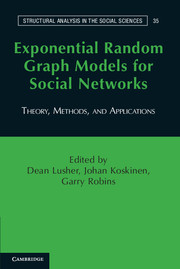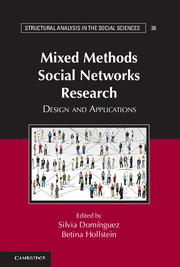Exponential Random Graph Models for Social Networks
Exponential random graph models (ERGMs) are increasingly applied to observed network data and are central to understanding social structure and network processes. The chapters in this edited volume provide a self-contained, exhaustive account of the theoretical and methodological underpinnings of ERGMs, including models for univariate, multivariate, bipartite, longitudinal and social-influence type ERGMs. Each method is applied in individual case studies illustrating how social science theories may be examined empirically using ERGMs. The authors supply the reader with sufficient detail to specify ERGMs, fit them to data with any of the available software packages and interpret the results.
- A self-contained book exclusively on the topic of exponential random graph models
- Addresses theory, method and applications of exponential random graph models
Reviews & endorsements
'I've been waiting impatiently for this book and I was definitely not disappointed. Finally we have a sourcebook on ERGMs that is both comprehensive and comprehensible. Most of the chapters are written for quantitative researchers who are not statisticians. Many illustrative empirical applications are worked through. Software packages are discussed. For the researcher who is intrigued by the possibility of analyzing network data with an ERGM, or who is already trying to do so, this is an indispensable resource.' Peter Carrington, University of Waterloo
'This collection offers readers an intuitive understanding of ERGMs, followed by a formal explanation of their statistical underpinnings as well as a methodological cookbook based on current software. Next, network scholars at the forefront of advancing theoretical and methodological contributions present eight compelling empirical studies. These studies illustrate how ERGMs offer exciting opportunities to advance theoretical understandings of network phenomena at the intra-organizational, inter-organizational, and societal levels.' Noshir Contractor, Jane S. and William J. White Professor of Behavioral Sciences, Northwestern University
'p*, the exponential family of random graph distributions introduced by Frank and Strauss in 1986, has indeed become the best statistical model in network science. This edited volume is a must-have - Lusher, Koskinen, and Robins have put together a thorough compilation for both the p* novice and enthusiast. It is the handbook to own - and use!' Stanley Wasserman, Indiana University
Product details
January 2013Paperback
9780521141383
360 pages
226 × 152 × 23 mm
0.48kg
71 b/w illus.
Available
Table of Contents
- Introduction Dean Lusher, Johan Koskinen and Garry Robins
- 1. What are exponential random graph models Garry Robins and Dean Lusher
- 2. The formation of social network structure Dean Lusher and Garry Robins
- 3. A simplified account of ERGM as a statistical model Garry Robins and Dean Lusher
- 4. An example of ERGM analysis Dean Lusher and Garry Robins
- 5. Exponential random graph model fundamentals Johan Koskinene and Galina Daraganova
- 6. Dependence graphs and sufficient statistics Johan Koskinen and Galina Daraganova
- 7. Social selection, dyadic covariates and geospatial effects Garry Robins and Galina Daraganova
- 8. Autologistic actor attribute models Galina Daraganova and Garry Robins
- 9. ERGM extensions: models for multiple networks and bipartite networks Peng Wang
- 10. Longitudinal models Tom Snijders and Johan Koskinen
- 11. Simulation, estimation and goodness of fit Johan Koskinen and Tom Snijders
- 12. Illustrations: simulation, estimation and goodness of fit Garry Robins and Dean Lusher
- 13. Personal attitudes, perceived attitudes and social structures: a social selection model Dean Lusher and Garry Robins
- 14. How to close a hole: exploring alternative closure mechanisms in inter-organizational networks Alessandro Lomi and Francesca Pallotti
- 15. Interdependencies between working relations: multivariate ERGMs for advice and satisfaction Yu Zhao and Olaf Rank
- 16. Brain, brawn or optimism? The structure and correlates of emergent military leadership Yuval Kalish and Gil Luria
- 17. An ALAAM analysis of unemployment: the dual importance of who you know and where you live Galina Daraganova and Philippa Pattison
- 18. Longitudinal changes in face-to-face and text message-mediated friendship networks Tasuku Igarashi
- 19. The differential impact of directors' social and financial capital on corporate interlock formation Nicholas Harrigan and Matthew Bond
- 20. Comparing networks: a structural correspondence between behavioural and recall networks Eric Quintane
- 21. Modelling social networks: next steps Philippa Pattison and Tom Snijders.







